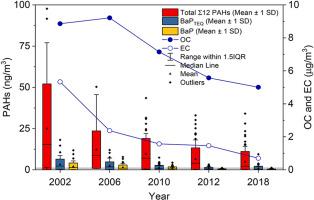当前位置:
X-MOL 学术
›
Atmos. Environ.
›
论文详情
Our official English website, www.x-mol.net, welcomes your feedback! (Note: you will need to create a separate account there.)
Long-term (1993–2018) particulate polycyclic aromatic hydrocarbons (PAHs) concentration trend in the atmosphere of Seoul: Changes in major sources and health effects
Atmospheric Environment ( IF 5 ) Pub Date : 2024-02-27 , DOI: 10.1016/j.atmosenv.2024.120418 Eunlak Choi , Ji Yi Lee , Yong Pyo Kim
Atmospheric Environment ( IF 5 ) Pub Date : 2024-02-27 , DOI: 10.1016/j.atmosenv.2024.120418 Eunlak Choi , Ji Yi Lee , Yong Pyo Kim

|
This study assessed the long-term concentration trend and profiles of twelve polycyclic aromatic hydrocarbons (PAHs) occurring as airborne particulate matter in Seoul, Republic of Korea (Korea) between 1993 and 2018 to evaluate the human health effect and the effectiveness of air quality management policies. Total PAHs (∑PAHs of 12 compounds), benzo [a]pyrene (BaP), and BaP toxic equivalent (BaP) concentrations increased from 1993 to 1999 but decreased thereafter. Moreover, the BaP concentration has remained below 1 ng/m since 2010–2011. Benzo [b+k]fluoranthene (B [b+k]F) accounted for the largest ∑PAHs fraction (approximately 24%) for the entire period. Based on the PAH profiles, as well as the Principal Component Analysis (PCA) results and diagnostic ratio analysis, vehicular emissions and coal combustion were identified as major sources of the PAHs in Seoul. Additionally, contribution of vehicular emissions increased from 2002 to 2003 to 2018, whereas that of solid fuel combustion decreased in the same period. PAH levels increased 8-fold in winter compared to summer mainly due to increases in local and regional emissions. The implementation of policies to regulate the use of solid fuels and vehicular emissions in Korea effectively reduced Elemental Carbon (EC) and PAH emissions, as demonstrated by CO, EC, and PAHs reductions and a good correlation between EC and PAHs. Moreover, aggressive air quality management policies in China have also contributed to decreasing PAH concentration trend in Seoul. Following the incremental lifetime cancer risk (ILCR) estimations method for 8 different population groups, males in the 0–1 age group was the only group still at potential risk of PAH inhalation in 2018, while other groups have been in the acceptable risk since 2012–2013.
更新日期:2024-02-27



























 京公网安备 11010802027423号
京公网安备 11010802027423号